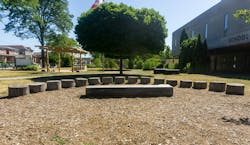Outdoor learning spaces, especially in regions of the country with warm climates, have been an important element of school campuses for many years, but their value has increased as educators responded to the Covid-19 pandemic by pivoting to safer ways of delivering instruction.
Students were at greater risk of contracting Covid-19 indoors, so the availability of outdoor areas with freely circulating fresh air not only offered a less risky learning environnment that had the desired physical distancing but also provided a change of pace that could spark student engagement.
Most schools can lay claim to some space outside the walls of their buildings, but what should an outdoor learning space consist of?
Green Schoolyards America, an advocate for outdoor school classrooms and a leader in the National Covid-19 Outdoor Learning Initiative, has recommendations for the kinds of seating and work surfaces that should be part of a school's outdoor space. The recommendations encompass four categories: low and no cost; low-cost portable solutions; moderate investment; and larger capital investment.
Low or no cost
Use existing seating. Many campuses have existing seating areas--lawns, picnic tables, bleachers, built-in amphitheaters, and concrete walls. This seating can be easily adapted to accommodate physical distancing.
Reconfigure existing seating. Gather existing picnic tables or other types of seating already on campus and move them to a central location to organize them as classrooms that incorporate physical distancing.
Straw bales. Straw bales are about 36 inches long and 18 inches wide and can seat one student each. If allergies, scratchy surfaces, or insects are a concern, assign each student a large rectangle of outdoor fabric to lay over the bale, or give each student a seat cushion to place on the bale.
Logs and stumps. Local arborists and park managers who remove trees that fall after a storm often have access to logs that can be repurposed as seating for outdoor learning.
Low-cost portable
Move indoor furniture outdoors. Classroom desks, tables, and chairs can be moved outdoors for an individual instructional period or an entire day. Most indoor furniture will need to be moved back inside at the end of each day unless it is placed in a sheltered location.
Buy outdoor seating. Many types of low-cost outdoor chairs, stools, and cushions are available, such as lawn, beach, and camping chairs. A pouch can be placed on the backs of chairs to hold folders, notebooks, and papers.
Use picnic blankets. Blankets are a comfortable option for short periods of outdoor instruction.
Buy mats. Small mats made from plastic or rubber are easy to clean between uses. Examples include kindergarten mats, yoga mats cut in half, stadium cushions, or rubber play tiles.
Buy crates and 5-gallon buckets. Plastic crates or 5-gallon buckets with lids are very portable and make durable, movable seats. They can double as both seating and a vessel to carry supplies.
Moderate investment
Buy or build picnic tables. Designs can include bench seating on two sides of a table, one bench whose back folds down into a table, or tables in the shape of a square, hexagon, or circle.
Build benches. Benches can be built from recycled materials and from untreated lumber cut from weatherproof woods such as cedar or redwood. Benches can be secured with concrete footings or similar techniques to minimize protrusions and vandalism.
Add rocks and boulders. Stones make attractive, interesting, and long-lasting outdoor seating. Schools can partner with local quarries or businesses that sell stone to find boulders that meets bench height requirements for students.
Larger capital investment
Install permanent benches and seats. Permanent seating can be artfully handmade or commercially produced from a variety of materials such as carved wood, mosaic on concrete, or metal.
Create council rings. These outdoor gathering spaces are typically made from stone or wood benches arranged in a circle. Circular benches allow for conversation and collaboration.
Construct amphitheaters. Amphitheater seating can be built into existing or constructed slopes and surfaced with grass, inset logs, or benches made from stone or other materials.
Other considerations
Access. Seating areas should not block emergency access or in any way impede safety on a school campus.
Topography. Seating should be placed on a flat or gently sloped area to ensure that seating is easily accessible for everyone.
Flexibility. Consider active seating options that enable students to change position as needed and sit upright, recline, curl up, stretch out, or stand.
Comfort. Unpadded seating is comfortable enough for short periods. For longer periods, consider softer, padded seating and incorporate time for movement breaks.
Work surfaces. In addition to seating, students may need work surfaces. These surfaces can be portable (e.g., clipboards, lap desks) or permanent (e.g., tables, individual desks).
About the Author
Mike Kennedy
Senior Editor
Mike Kennedy has been writing about education for American School & University since 1999. He also has reported on schools and other topics for The Chicago Tribune, The Kansas City Star, The Kansas City Times and City News Bureau of Chicago. He is a graduate of Michigan State University.
